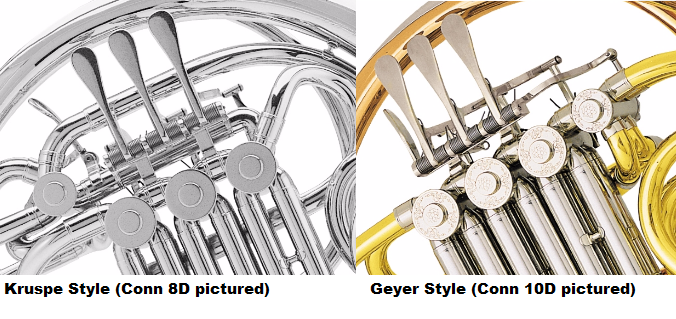Most french horn models can be categorized into two design layouts: the Kruspe and the Geyer, named after their original makers Edward Kruspe and Carl Geyer — pioneers in horn design in the early 20th century. Over the years, other horn makers have copied and modified these original designs to suite various tastes — from the Kruspe-style Conn 8D and Yamaha 668II with their big bold sound, to the Geyer-style Conn 10D and Yamaha 667 with its brighter more nuanced qualities. While other makers such as Paxman and Schmid have developed more distinctive variations, but all share elements of the original Kruspe and Geyer horns.
Geyer horns
A German born American, Carl Geyer moved to Chicago in 1904 at the age of 24 with a musical instrument making apprenticeship under his belt. 15 years later, he would open his famous horn making shop. His “shop was extremely disorderly. It was a tiny room with high ceilings,” remembered Thomas Bacon. Despite the disorder, his horns were considered works of art by their players, thanks to the level of individual customization Geyer performed for each player’s unique style.
The Geyer horn is recognized by the layout of its rotor valves. The B-flat rotor, controlled by the thumb key to turn the horn from F to B-flat, is located in line with the three other values. This configuration results in less bends in the tubing, giving the F side of the horn less resistance and allowing a better blended sound between F and B-flat sides of the instrument. This also helps the horn achieve nicer slurs between notes, but can also make it more difficult to attack the notes initially.
In addition to less bends in the tubing, Geyer-style horns have smaller bells which results in a brighter, more controllable tone quality. For this reason, many Geyer models are made in brass which helps to darken the bright-leaning design layout.
Kruspe horns
A maker of brass instruments in the German town of Eisenach, Edward Kruspe is believed to have build the first double horn prototype, based on a design by horn player and professor Edmund Gumpert [John Ericson, Horn Call Feb 1998]. The Kruspe company existed until 2011, but its horns were overtaken by other makers using the same original design.
The Kruspe design layout features the B-flat change value close to the thumb key. This configuration results in several tubing bends that don’t exist in the Geyer design, leading to the “closed wrap” name. There are some advantages to this extra tubing, including more options to tune the horn on the B-flat side and also easier ability to empty water from the instrument. These bends also result in more resistance, which the Kruspe design counterbalances with a larger bell. This resistance combined with a big open bell, gives the horn its unique playing qualities and characteristic dark tone.
Movie scores have traditionally featured Kruspe wrap horns, and until more recently, they were standard in American orchestras most notably Philadelphia and New York.
Which style–Kruspe or Geyer–is right for you? There are both good and poor quality horns made in both layouts. In the professional world, players are increasingly gravitating toward custom-made Geyer horns by the likes of Hill and Rauch. But if you’re seeking value for the money, Kruspe horns can be found at good prices and many of the factory made versions are of good quality.
NEXT: Read our reviews of 15+ horn models and contribute your own.
